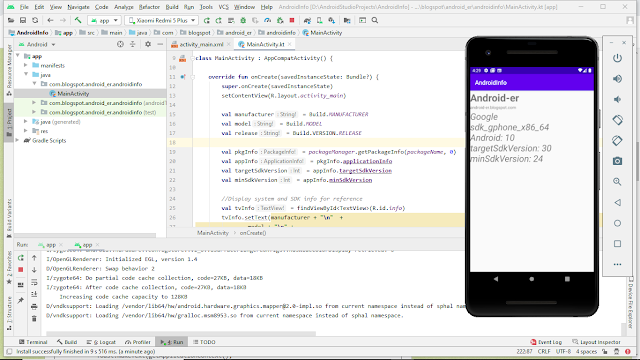This example show how to detect touch on individual view.
Example code
package com.blogspot.android_er.exmyview
import android.os.Build
import androidx.appcompat.app.AppCompatActivity
import android.os.Bundle
import android.view.MotionEvent
import android.widget.ImageView
import android.widget.TextView
/*
ref:
https://developer.android.com/training/gestures/detector#capture-touch-events-for-a-single-view
Android Developers Guides > Detect common gestures > Capture touch events for a single view
*/
class MainActivity : AppCompatActivity() {
private lateinit var ivIcon: ImageView
private lateinit var tvSysInfo: TextView
private lateinit var tvSdkInfo: TextView
private lateinit var tvConsole: TextView
override fun onCreate(savedInstanceState: Bundle?) {
super.onCreate(savedInstanceState)
setContentView(R.layout.activity_main)
ivIcon = findViewById(R.id.icon)
tvSysInfo = findViewById(R.id.sysinfo)
tvSdkInfo = findViewById(R.id.sdkinfo)
tvConsole = findViewById(R.id.console)
val manufacturer = Build.MANUFACTURER
val model = Build.MODEL
val release = Build.VERSION.RELEASE
val pkgInfo = packageManager.getPackageInfo(packageName, 0)
val appInfo = pkgInfo.applicationInfo
val targetSdkVersion = appInfo.targetSdkVersion
val minSdkVersion = appInfo.minSdkVersion
tvSysInfo.text = manufacturer + "\n" +
model + "\n" + "Android: " + release
tvSdkInfo.text = "targetSdkVersion: " + targetSdkVersion + "\n" +
"minSdkVersion: " + minSdkVersion
tvConsole.text = "Android Example:" +
"\nCapture touch events for a single view"
ivIcon.setOnTouchListener { v, event -> // ... Respond to touch events
/*
return true if the listener has consumed the event, false otherwise.
*/
val action = event.action
when (action) {
MotionEvent.ACTION_DOWN -> {
/*
Beware of creating a listener that returns false
for the ACTION_DOWN event.
If you do this, the listener will not be called
for the subsequent ACTION_MOVE and ACTION_UP string of events.
This is because ACTION_DOWN is the starting point for all touch events.
*/
tvConsole.text = "ACTION_DOWN@ivIcon"
true}
MotionEvent.ACTION_MOVE -> {
tvConsole.append("\nACTION_MOVE@ivIcon")
true}
MotionEvent.ACTION_UP -> {
tvConsole.text = "ACTION_UP@ivIcon"
true}
MotionEvent.ACTION_CANCEL -> {
tvConsole.text = "ACTION_CANCEL@ivIcon"
true}
MotionEvent.ACTION_OUTSIDE -> {
tvConsole.text = "ACTION_OUTSIDE@ivIcon"
true}
else -> super.onTouchEvent(event)
}
}
tvSysInfo.setOnTouchListener { v, event -> // ... Respond to touch events
when (event.action) {
MotionEvent.ACTION_DOWN -> {
tvConsole.text = "ACTION_DOWN@tvSysInfo"
true}
MotionEvent.ACTION_MOVE -> {
tvConsole.append("\nACTION_MOVE@tvSysInfo")
true}
MotionEvent.ACTION_UP -> {
tvConsole.text = "ACTION_UP@tvSysInfo"
true}
MotionEvent.ACTION_CANCEL -> {
tvConsole.text = "ACTION_CANCEL@tvSysInfo"
true}
MotionEvent.ACTION_OUTSIDE -> {
tvConsole.text = "ACTION_OUTSIDE@tvSysInfo"
true}
else -> super.onTouchEvent(event)
}
}
tvSdkInfo.setOnTouchListener { v, event -> // ... Respond to touch events
when (event.action) {
MotionEvent.ACTION_DOWN -> {
tvConsole.text = "ACTION_DOWN@tvSdkInfo"
true}
MotionEvent.ACTION_MOVE -> {
tvConsole.append("\nACTION_MOVE@tvSdkInfo")
true}
MotionEvent.ACTION_UP -> {
tvConsole.text = "ACTION_UP@tvSdkInfo"
true}
MotionEvent.ACTION_CANCEL -> {
tvConsole.text = "ACTION_CANCEL@tvSdkInfo"
true}
MotionEvent.ACTION_OUTSIDE -> {
tvConsole.text = "ACTION_OUTSIDE@tvSdkInfo"
true}
else -> super.onTouchEvent(event)
}
}
}
}
layout
<?xml version="1.0" encoding="utf-8"?>
<LinearLayout
xmlns:android="http://schemas.android.com/apk/res/android"
xmlns:app="http://schemas.android.com/apk/res-auto"
xmlns:tools="http://schemas.android.com/tools"
android:layout_width="match_parent"
android:layout_height="match_parent"
android:orientation="horizontal"
tools:context=".MainActivity">
<LinearLayout
android:id="@+id/leftpanel"
android:layout_width="0dp"
android:layout_height="match_parent"
android:layout_weight="1"
android:orientation="vertical"
android:background="#E0E0E0"
android:layout_margin="5dp">
<ImageView
android:id="@+id/icon"
android:layout_width="wrap_content"
android:layout_height="wrap_content"
android:layout_margin="5dp"
android:padding="5dp"
android:background="#0000F0"
android:src="@mipmap/ic_launcher_round"/>
<TextView
android:id="@+id/sysinfo"
android:layout_width="match_parent"
android:layout_height="wrap_content"
android:layout_margin="5dp"
android:padding="5dp"
android:background="#0000D0"
android:textSize="20dp"
android:textStyle="bold"
android:textColor="@color/white"/>
<TextView
android:id="@+id/sdkinfo"
android:layout_width="match_parent"
android:layout_height="wrap_content"
android:layout_margin="5dp"
android:padding="5dp"
android:background="#0000B0"
android:textSize="20dp"
android:textStyle="bold"
android:textColor="@color/white"/>
</LinearLayout>
<LinearLayout
android:id="@+id/rightpanel"
android:layout_width="0dp"
android:layout_height="match_parent"
android:layout_weight="1"
android:orientation="vertical"
android:background="#C0C0C0">
<TextView
android:layout_width="match_parent"
android:layout_height="wrap_content"
android:layout_margin="5dp"
android:padding="5dp"
android:textSize="20dp"
android:textStyle="bold"
android:textColor="@color/white"
android:text="android-er.blogspot.com"/>
<TextView
android:id="@+id/console"
android:layout_width="wrap_content"
android:layout_height="wrap_content"
android:layout_margin="5dp"
android:padding="5dp"
android:textSize="30dp"
android:textStyle="bold"
android:gravity="bottom"/>
</LinearLayout>
</LinearLayout>


















